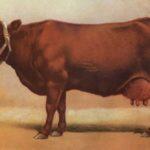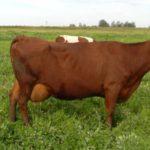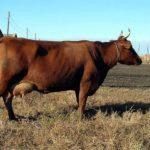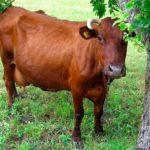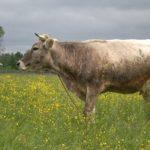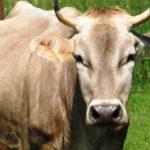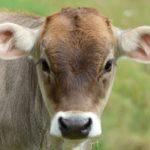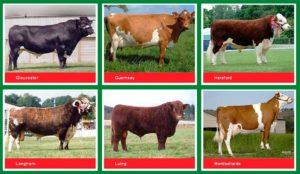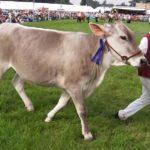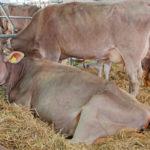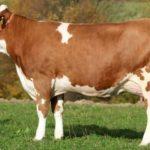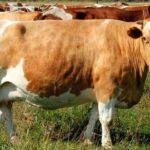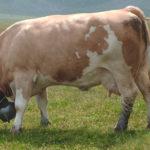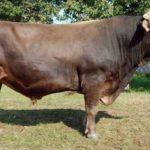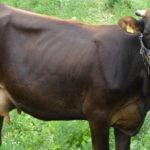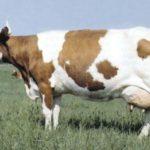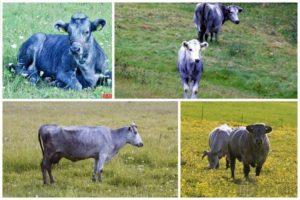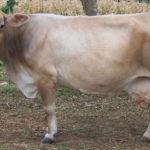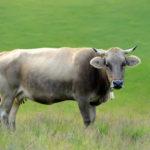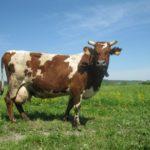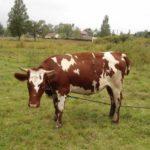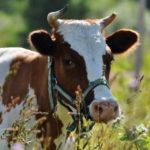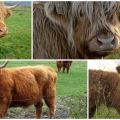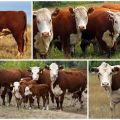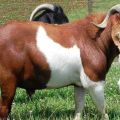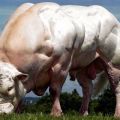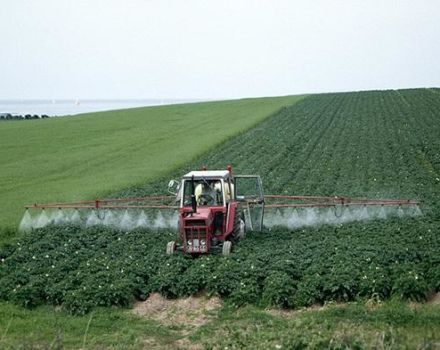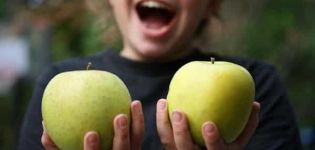In which region of Russia is meat and dairy production and top 10 breeds developed?
The meat and dairy sectors of agriculture are narrow-profile areas that are engaged on an industrial scale. Animals provide only milk or meat, but show high productivity. Meat and dairy business - mixed specialization. Cattle that provide milk and meat are raised on private farms for their own needs. Before buying, you need to learn more about the breeds of dairy cows and in which areas they are bred.
Features of the direction
The performance of dual purpose cows may differ in favor of meat or dairy products, and exterior imperfections reduce meat quality. Differences between meat and dairy cows from narrow-profile:
- versatility;
- unpretentiousness in nutrition;
- maintaining productivity in cold climates.
Meat and dairy breeds can be crossed with narrowly targeted.
The best meat and dairy cows
In domestic farms, 10 meat and dairy breeds are most often grown.
Bestuzhevskaya
The breed appeared in the 18th century in the village of Repyevka on the farm of the breeder Bestuzhev. Local cows were crossed with Shorthorn, Dutch and Simmental breeds. The resulting specimens were distinguished by an elongated body, larger size, and strong bones. Color - all shades of red, including cherry, with white spots on the belly, head and chest.
Animals are highly reproductive, unpretentious in care and feeding. Valuable meat is obtained from cows with a straight, wide back. The shortcomings of the exterior attribute the Bestuzhev breed to the dairy type. It is bred at home - in the Ulyanovsk region, as well as on the farms of the Samara and Penza regions.
Krasnogorbatovskaya
The breed was bred in the Nizhny Novgorod region as a result of crossing local and Tyrolean cows. The cross is distinguished by a strong and dense constitution. Color - cherry red. Krasnogorbatovskaya breed is mainly a meat direction.
Krasnogorbatovskaya breed is bred on the farms of the Nizhny Novgorod, Ivanovo and Vladimir regions.
Kostroma breed
A variety of cows with a dual orientation was approved after the end of the Great Patriotic War. She was raised on the Karavaevo farm. The selection used the Yaroslavl, Swiss and Algaus breeds. As a result, individuals with a wide body, powerful skeleton and prominent muscles appeared. The coat is colored in light and dark shades of gray. Kostroma cows are highly productive breeds.
Kostroma cows are adapted to a harsh climate and increase their milk yield on cheap coarse forage.
Swiss breed
The ancestors of the Swiss cows are local Swiss and short-legged ancient Eastern livestock. As a result of selective selection, a Swiss breed with voluminous loose muscles, a wide chest, a shorter body and large horns arose. The coat is colored in a light gray shade, dark brown is less common. The back from withers to tail is lighter than the sides and belly.
Females have underdeveloped udders, so milk is pumped at too low a speed for milking machines - 1.3 liters per minute. Swiss cows need free grazing in the summer in fields planted with legumes and red clover. Therefore, for good nutrition, you will need to organize an artificial pasture. Also, the diet should contain hay, silage, fresh vegetables and bran, as well as a sufficient amount of water.
Farms of the Tula, Bryansk, Smolensk, Nizhny Novgorod regions, as well as the Krasnodar Territory, are engaged in breeding the Swiss breed.
Simmental breed
The name comes from the Simmental Valley, where the breed was bred from Swiss and Scandinavian cattle. Russian breeders crossed foreign animals with local cows and raised regional modifications of the breed - the Urals, Far Eastern, Siberian, Volga. Color - fawn, variegated with a red tint, with a white tail tip, light horns and hooves.
Females are ready for mating in the second year of life. The daily norm of dry food for the Simmental is 7 kilograms, and for juicy food - 4 kilograms. Pregnant and dairy cows need more food. The Simmental breed is widespread in the Urals, southern Siberia, in all regions of the European part of Russia, except for the northwestern district.
Caucasian brown
The motherland of the cows is the Caucasus, and the ancestors are Kostroma, Lebedinsky and Schwyts.Animals are distinguished by their strong constitution and brown color.
Caucasian cows bring up to three calves per litter. The Caucasian variety requires grazing on an artificial pasture with wheat, rye and alfalfa in the highlands. Therefore, it is common in Dagestan.
Arautskaya
The Kazakh breed is characterized by a strong build with short legs and a brown color.
The Araut cow is an unpretentious animal that is suitable for grazing without a leash.
Lebedinskaya
The breed was bred by Ukrainian breeders by crossing Sumy cows and Swiss. Features of the Lebedinskaya variety are well-developed muscles, straight legs and a large udder. Color - light gray or light brown.
Lebedinsky cows are common in the central regions of Russia.
Yakutsk
The ancestors of the breed are the sacred humpbacked zebu cows, common in India. Therefore, the exterior of animals is distinguished by a convex withers and long warm hair. Yakut cattle are on the verge of extinction. For partial preservation, they were crossed with Simmental.
Thoroughbred livestock is available only in the Novosibirsk nursery at the Research Institute of Agriculture and in individual private farms. Yakut cows are the most unpretentious, they survive in a frost of -50 degrees and a meager diet.
Yorkshire breed
The variety was developed by Scottish farmers in the 19th century. The horns of bulls with curved ends resemble a lyre in shape. Color - red-motley, less often black, chocolate.
To produce a liter of milk, a Yorkshire cow needs 880 grams of feed, while other breeds need 5 kilograms. Salt and chalk should be given to pregnant cows. The distribution area is the northern regions of Russia.
Subtleties of keeping at home
Basic information about the maintenance of meat and dairy cows is shown in the table:
| Content type | Stable-pasture |
| Feeding mode | In winter 3-5 times a day, in summer open access to feed in the pasture, when fattening food should always be available
|
| Drinking mode | In summer 1-2 times a day, in winter - after meals |
| Fattening for meat | Four to ten months |
| Milking | 2-3 times a day, if there is a lot of milk - more often, but always at regular intervals and at the same time
|
| Vaccination | Salmonellosis - at the age of one month. Anthrax - 1.5-4 months. Foot and mouth disease - from 3 months and annually throughout life. Rabies - at 6 months.
|
Livestock of dual orientation can be kept on free pasture with wintering in stalls or permanently kept in the barn and taken out for a walk.The barn should be kept clean and the litter should be changed as often as necessary to maintain fresh air in the barn.

